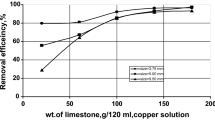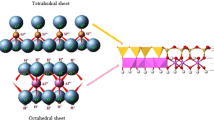Abstract
A batch sorption method was used to study the removal of few toxic metals onto the Late Cretaceous clays of Aleg formation (Coniacian–Lower Campanian system), Tunisia, in single, binary and multi-component systems. The collected clay samples were used as adsorbents for the removal of Pb(II), Cd(II), Cu(II) and Zn(II) from aqueous solutions. Results show that the natural clay samples were mainly composed of silica, alumina, iron and magnesium oxides. N2-adsorption measurements indicated mesoporous materials with modest specific surface area of <71 m2/g. Carbonate minerals were the most influencing parameters for heavy metal removal by natural clays in both single and multi-element systems. The affinity sequence was Pb(II)>Cu(II)>Zn(II)>Cd(II) due to the variable physical properties of the studied metals. The maximum adsorption capacity reached 131.58 mg/g in single systems, but decreased to <50.10 mg/g in mixed systems. In single, binary and muti-element systems, the studied clay samples removed substantial amounts of heavy metals, showing better effectiveness than the relevant previous studies. These results suggest that the studied clay samples of the Late Cretaceous clays from Tunisia can be effectively used as natural adsorbents for the removal of toxic heavy metals in aqueous systems.








Similar content being viewed by others
References
Abdeljaouad, S. (1983). Etude stratigraphique, sédimentologique et structurale de l’extrémité orientale de la Chaîne Nord des Chotts. PhD thesis, Fac Sci, Univ Tunis II, Tunisia.
Al-Degs, Y. S., El-Barghouthi, M. I., Issa, A. A., Khraisheh, M. A., & Walker, G. M. (2006). Sorption of Zn(II), Pb(II), and Co(II) using natural sorbents: equilibrium and kinetic studies. Water Research, 40, 2645–2658.
Appel, C., Ma, L. Q., Rhue, R. D., & Reve, W. (2008). Sequential sorption of lead and cadmium in three tropical soils. Environmental Pollution, 155, 132–140.
Arpa, C., Say, R., Satiroglu, N., Yurum, S., Bektas, Y., & Genc, O. (2000). Heavy metal removal from aquatic systems by northern Anatolian smectites. Turkish Journal of Chemistry, 24, 209–215.
Ben Hadj, A., Jedoui, Y., Dali, T., Ben Salem, N., Memmi, L. (1985). Carte géologique de la Tunisie à 1/500,000, Office National des Mines, Service Géologique National, Tunisie
Burollet, P. F. (1956). Contribution à l’étude stratigraphique de la Tunisie Centrale. Annales de Mines et de la Géologie, 18, 345.
Chaari, I., Fakhfakh, E., Chakroun, S., Bouzid, J., Boujelben, N., Feki, M., et al. (2008). Lead removal from aqueous solutions by a Tunisian smectitic clay. Journal of Hazardous Materials, 156, 545–551.
Corami, A., Mignardi, S., & Ferrini, V. (2007). Copper and zinc decontamination from single- and binary-metal solutions using hydroxyapatite. Journal of Hazardous Materials, 146, 164–170.
Darder, M., Colilla, M., & Ruiz-Hitzky, E. (2005). Chitosan–clay nanocomposites: application as electrochemical sensors. Applied Clay Sciences, 28, 199–208.
Echeverria, J. C., Morera, M. T., Mazkiaran, C., & Garrido, J. J. (1998). Competitive sorption of heavy metal by soils. Isotherms and fractional factorial experiments. Environmental Pollution, 101, 275–284.
Eloussaief, M., & Benzina, M. (2010). Efficiency of natural and acid-activated clays in the removal of Pb(II) from aqueous solutions. Journal of Hazardous Materials, 178, 753–757.
Eloussaief, M., Jarraya, I., & Benzina, M. (2009). Adsorption of copper ions on two clays from Tunisia: pH and temperature effects. Applied Clay Sciences, 46, 409–413.
Eloussaief, M., Kallel, N., Yaacoubi, A., & Benzina, M. (2011). Mineralogical identification, spectroscopic characterization, and potential environmental use of natural clay materials on chromate removal from aqueous solutions. Chemical Engineering Journal, 168, 1024–1031.
Ghorbel-Abid, I., Galai, K., & Trabelsi-Ayadi, M. (2010). Retention of chromium (III) and cadmium (II) from aqueous solution by illitic clay as a low-cost adsorbent. Desalination, 256, 190–195.
Guerra, D. L., Bastita, A. C., Corrêa da costa, P. C., Viana, R. R., & Airoldi, C. (2010). Adsorption of arsenic ions on Brazilian sepiolite: effect of contact time, pH, concentration, and calorimetric investigation. Journal of Colloid and Interface Science, 346, 178–187.
Jarraya, I., Fourmentin, S., Benzina, M., & Bouaziz, S. (2010). VOCs adsorption on raw and modified clay materials. Chemical Geology, 275, 1–8.
Kaya, A., & Hakan Ören, A. (2005). Adsorption of zinc from aqueous solutions to bentonite. Journal of Hazardous Materials, 125, 183–189.
Kinraide, T. B., & Yermiyahu, U. (2007). A scale of metal ion binding strengths correlating with ionic charge, Pauling electronegativity, toxicity, and other physiological effects. Journal of Inorganic Biochemistry, 101, 1201–1213.
Lin, S. H., & Juang, R. S. (2002). Heavy metal removal from water by sorption using surfactant-modified montmorillonite. Journal of Hazardous Materials, 92, 315–326.
Mahamadi, C., & Nharingo, T. (2010). Competitive adsorption of Pb2+, Cd2+ and Zn2+ ions onto Eichhornia crassipes in binary and ternary systems. Bioresource Technology, 101, 859–864.
Markiewicz-Patkowska, J., Hursthouse, A., & Przybyla-Kij, H. (2004). The interaction of heavy metals with urban soils: sorption behaviour of Cd, Cu, Cr, Pb and Zn with a typical mixed brownfield deposit. Environmental Pollution, 31, 513–521.
Mejri, F., Burollet, P. F., Ben Ferjani, A. (2006). Petroleum geology of Tunisia, a renewed synthesis. Mémoire N° 22, Entreprise tunisienne des activités petrolières, Tunisia.
Mesquita, M. E., & Vieira e Silva, J. M. (1996). Zinc adsorption by a calcareous soil. Copper interaction. Geoderma, 69, 137–146.
Minceva, M., Markovska, L., & Meshko, V. (2007). Removal of Zn2+, Cd2+ and Pb2+ from binary aqueous solution by natural zeolite and granulated activated carbon. Macedonian Journal of Chemistry and Chemical Engineering, 26, 125–134.
Morales Futalan, C., Kan, C., Lourdes Dalida, M., Hsien, K., Pascua, C., & Wan, M. (2011). Comparative and competitive adsorption of copper, lead, and nickel using chitosan immobilized on bentonite. Carbohydrate Polymers, 83, 528–536.
Oh, S., Kwak, M. Y., & Shin, W. S. (2009). Competitive sorption of lead and cadmium onto sediments. Chemical Engineering Journal, 152, 376–388.
Oubagaranadin, J. U. K., Murthy, Z. V. P., & Mallapur, Z. V. P. (2010). Removal of Cu(II) and Zn(II) from industrial wastewater by acid-activated montmorillonite–illite type of clay. Comptes Rendus Chimie, 13, 1359–1363.
Pagnanelli, F., Esposito, A., Toro, L., & Veglio, F. (2003). Metal speciation and pH effect on Pb, Cu, Zn and Cd biosorption onto Sphaerotilus natans: Langmuir-type empirical model. Water Research, 37, 627–633.
Pentari, D., Perdikatsis, V., Katsimicha, D., & Kanaki, A. (2009). Sorption properties of low calorific value Greek lignites: removal of lead, cadmium, zinc and copper ions from aqueous solutions. Journal of Hazardous Materials, 168, 1017–1021.
Qin, F., Wen, B., Shan, X. Q., Xie, Y. N., Liu, T., Zhang, S. Z., et al. (2006). Mechanisms of competitive adsorption of Pb, Cu, and Cd on peat. Environmental Pollution, 144, 669–680.
Saha, U. K., Taniguchi, S., & Sakurai, K. (2002). Simultaneous adsorption of cadmium, zinc, and lead on hydroxyaluminum- and hydroxyaluminosilicate–montmorillonite complexes. Soil Science Society of America Journal, 66, 117–128.
Sari, A., Tuzen, M., Citak, D., & Soylak, M. (2007a). Equilibrium, kinetic and thermodynamic studies of adsorption of Pb(II) from aqueous solution onto Turkish kaolinite clay. Journal of Hazardous Materials, 149, 283–291.
Sari, A., Tuzen, M., & Soylak, M. (2007b). Adsorption of Pb(II) and Cr(III) from aqueous solution on Celtik clay. Journal of Hazardous Materials, 144, 41–46.
Schaller, M. S., Koretsky, C. M., Lund, T. J., & Landry, C. J. (2009). Surface complexation modeling of Cd(II) adsorption on mixtures of hydrous ferric oxide, quartz and kaolinite. Journal of Colloid and Interface Science, 339, 302–309.
Sdiri, A., Higashi, T., Bouaziz, S., & Benzina, M. (2010a). Synthesis and characterization of silica gel from siliceous sands of southern Tunisia. Arabian Journal of Chemistry. doi:10.1016/j.arabjc.2010.11.007.
Sdiri, A., Higashi, T., Hatta, T., Jamoussi, F., & Tase, N. (2010b). Mineralogical and spectroscopic characterization, and potential environmental use of limestone from the Abiod formation, Tunisia. Environmental Earth Sciences, 61, 1275–1287.
Sdiri, A., Higashi, T., Hatta, T., Jamousssi, F., & Tase, N. (2011a). Evaluating the adsorptive capacity of montmorillonitic and calcareous clays on the removal of several heavy metals in aqueous systems. Chemical Engineering Journal, 172, 37–46.
Sdiri, A., Higashi, T., Jamoussi, F., & Bouaziz, S. (2011b). Effects of impurities on the removal of heavy metals by natural limestones in aqueous systems. Journal of Environmental Management. doi:10.1016/j.jenvman.2011.08.002.
Srivastava, P., Singh, B., & Angove, M. (2005). Competitive adsorption behavior of heavy metals on kaolinite. Journal of Colloid and Interface Science, 290, 28–38.
Ulmanu, M., Marañón, E., Fernández, Y., Castrillón, L., Anger, I., & Dumitriu, D. (2003). Removal of copper and cadmium ions from diluted aqueous solutions by low cost and waste material adsorbents. Water, Air, and Soil Pollution, 142, 357–373.
Usman, A. A. R. (2008). The relative adsorption selectivities of Pb, Cu, Zn, Cd and Ni by soils developed on shale in New Valley, Egypt. Geoderma, 144, 334–343.
Vidal, M., Santos, M. J., Abrão, T., Rodríguez, J., & Rigol, A. (2009). Modeling competitive metal sorption in a mineral soil. Geoderma, 149, 189–198.
Zhu, J., Pigna, M., Cozzolino, V., Caporale, A. G., & Violante, A. (2010). Competitive sorption of copper(II), chromium(III) and lead(II) on ferrihydrite and two organomineral complexes. Geoderma, 159, 409–416.
Acknowledgements
The authors gratefully acknowledge the financial support provided by Borj Cedria Science and Technology Park, Tunisia, in cooperation with the Japan Bank for International Cooperation (JBIC). The help of Mrs. Seiko Nemoto, assistant researcher in JIRCAS, Tsukuba, Mrs. Hiroko Sado and Mr Koichi Shimotori, research associate in the Chemical Analysis Division, University of Tsukuba, is greatly appreciated. The authors also extend their thanks to Professor Ahmet Sari from Gaziosmanpaşa University, Turkey for his prompt reviews and the time allocated to our manuscript.
Author information
Authors and Affiliations
Corresponding author
Rights and permissions
About this article
Cite this article
Sdiri, A., Higashi, T., Chaabouni, R. et al. Competitive Removal of Heavy Metals from Aqueous Solutions by Montmorillonitic and Calcareous Clays. Water Air Soil Pollut 223, 1191–1204 (2012). https://doi.org/10.1007/s11270-011-0937-z
Received:
Accepted:
Published:
Issue Date:
DOI: https://doi.org/10.1007/s11270-011-0937-z




